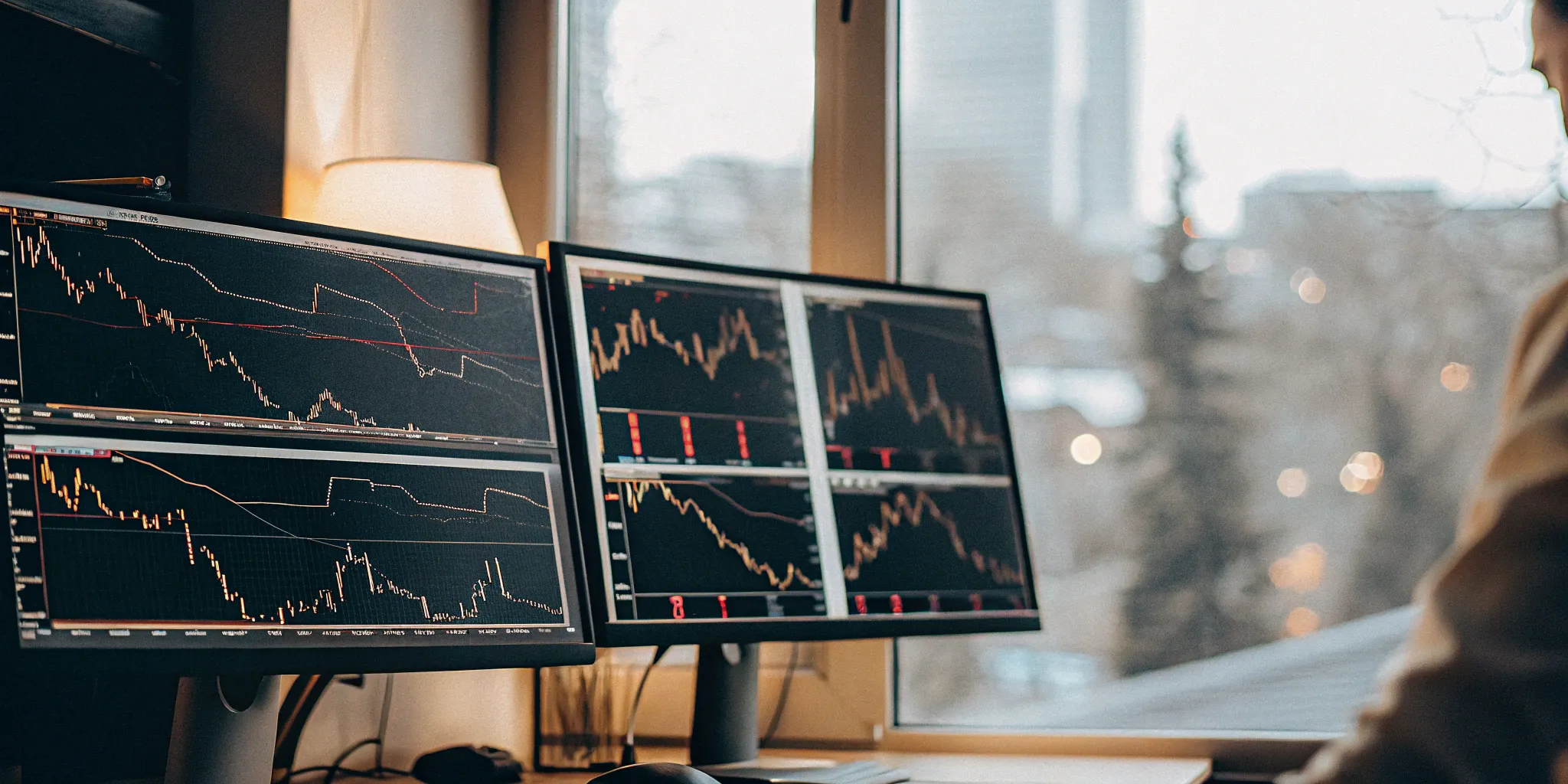Tired of second-guessing your investment decisions? Algorithmic trading offers a data-driven approach, removing emotion from the equation. By using computer programs to execute trades, you can achieve speed, precision, and consistency in your investment strategy. This guide provides a practical introduction to algorithmic trading, covering essential terms, common strategies, and risk mitigation techniques. Whether you’re a beginner or an experienced trader, understanding these concepts is crucial for success in today’s fast-paced markets. We’ve also included an algorithmic trading glossary to help you master the language of automated trading. Ready to take your investments to the next level? Let’s get started.
Key Takeaways
- Algorithmic trading automates your investment strategy: By removing emotional decision-making, it promotes faster execution and more disciplined adherence to your plan. Understanding the core concepts and available strategies is crucial for success.
- Risk management is essential for algorithmic trading: Metrics like alpha, beta, Sharpe ratio, and slippage provide crucial insights into performance and risk exposure. Employ techniques like stop-loss orders, diversification, and backtesting to protect your investments.
- Start your algorithmic trading journey with a strong foundation: Learn key terms, define your strategy, and prioritize risk management. Explore resources like FN Capital’s platform and educational materials to confidently navigate the world of automated trading.
What is Algorithmic Trading?
Algorithmic trading uses computer programs to execute trades automatically in financial markets. These programs, driven by algorithms, follow a defined set of rules for buying and selling assets. This automation aims to boost trading speed and accuracy while reducing human error. Essentially, it takes the emotion out of trading and relies on data-driven decisions. Think of it as having a tireless, emotionless expert working 24/7 to manage your investments.
Quantified Strategies defines algorithmic trading as “using computer programs to automatically buy and sell assets based on pre-set rules,” highlighting how technology streamlines the trading process. This automation allows for greater efficiency and minimizes the risks associated with manual trades, freeing you to focus on other aspects of your investment strategy.
Algorithmic trading isn’t a one-size-fits-all approach. It ranges from fully automated “black box” systems to semi-automated setups where human traders still have a role, according to the FIA. This flexibility allows traders to customize their level of involvement based on their comfort and strategy. You can choose the level of control that suits your needs.
While algo trading offers numerous advantages over traditional methods, like processing vast amounts of data and executing trades at optimal prices (as noted by The Robust Trader), it’s important to be aware of potential downsides. For example, algorithmic trading can sometimes amplify market volatility if not managed carefully. Understanding these nuances is key to successful implementation and maximizing your returns.

Essential Algorithmic Trading Terms
Understanding the core concepts of algorithmic trading is crucial for navigating this complex landscape. This glossary breaks down essential terms into market dynamics, trading strategies, and the technical aspects that drive automated trading systems.
Market Terms
-
Liquidity: Liquidity describes how easily you can buy or sell an asset without impacting its price. High liquidity means quick, efficient transactions, which is especially valuable in algorithmic trading, where speed is key. Think of a busy stock like Apple; it’s highly liquid because there are always buyers and sellers. Conversely, a thinly traded penny stock has low liquidity, making it harder to execute trades without moving the price.
-
Market Impact: Market impact refers to how a large trade can shift an asset’s price. Algorithmic traders aim to minimize this impact to avoid negatively affecting their returns. Imagine a whale suddenly selling a large chunk of Bitcoin; the sheer volume can push the price down. Skilled algorithmic traders use sophisticated techniques to execute large orders without causing drastic price swings, often involving breaking down large orders into smaller, less noticeable trades.
Strategy Terms
-
Arbitrage: Arbitrage is about capitalizing on price differences for the same asset in different markets. It’s a classic strategy in algorithmic trading, aiming to generate profits from these discrepancies. For example, if gold is cheaper on the London exchange than in New York, an arbitrageur would buy in London and simultaneously sell in New York, locking in a risk-free profit. While seemingly simple, effective arbitrage requires speed and precision, making it ideal for automated execution.
-
Pairs Trading: Pairs trading involves buying one asset and simultaneously selling a related one, anticipating their prices will eventually converge. This strategy often focuses on stocks within the same industry. For instance, if Coca-Cola and PepsiCo historically move together, a pairs trader might short PepsiCo and buy Coca-Cola if they believe PepsiCo is temporarily overvalued. The goal isn’t to predict the direction of either stock, but to profit from the eventual correction in their relative prices.
-
Mean Reversion: Mean reversion is a strategy based on the idea that asset prices tend to fluctuate around an average. Traders buy assets below their historical average, expecting them to rise, and sell assets above the average, expecting them to fall. This strategy is often used with commodities or currencies. For example, if the price of oil drops significantly below its historical average, a mean reversion trader might buy, anticipating a price increase.
-
Momentum Trading: Momentum trading capitalizes on existing price trends. Traders buy assets with rising prices, betting the trend will continue. This strategy can be highly effective in fast-moving markets but requires careful risk management. For example, a momentum trader might buy a tech stock that has shown consistent upward movement, hoping to ride the wave of increasing investor enthusiasm. This approach can be particularly lucrative in trending markets.
Technical Terms
-
Algorithmic Trading: Algorithmic trading uses computer programs to execute trades based on pre-defined rules. This automates the trading process, aiming for speed, efficiency, and accuracy while reducing human error. It’s a broad term encompassing various strategies, from simple automated order execution to complex high-frequency trading algorithms. Learn more about the intricacies of algorithmic trading systems.
-
Backtesting: Backtesting involves testing a trading strategy on historical data to evaluate its potential performance. It’s a crucial step in refining algorithms before live trading. Think of it as a dress rehearsal for your trading strategy. By simulating its performance on past market data, you can identify weaknesses and optimize its parameters.
-
Slippage: Slippage is the difference between the expected price of a trade and the price at which it’s actually executed. It’s an unavoidable part of trading, but algorithmic traders work to minimize it. Slippage can occur due to rapid price movements or low liquidity. For example, if you place an order to buy a stock at $10, but the price jumps to $10.05 before your order is filled, you’ve experienced 5 cents of slippage per share. Understanding slippage and how to manage it is essential for any trader.
Common Algorithmic Trading Strategies
Algorithmic trading comes in various forms, each designed to capitalize on different market behaviors. Let’s explore a few popular strategies:
Trend-Following Strategies
Trend-following strategies ride the momentum of market trends. These strategies involve buying assets with rising prices and selling those with falling prices, under the assumption that these trends will continue. The goal is to capture profits from sustained price movements. For more definitions of algorithmic trading terms, check out this helpful glossary.
Common Algorithmic Trading Strategies
Algorithmic trading comes in various forms, each designed to capitalize on different market behaviors. Let’s explore a few popular strategies:
Trend-Following Strategies
Trend-following strategies ride the momentum of market trends. These strategies involve buying assets with rising prices and selling those with falling prices, under the assumption that these trends will continue. The goal is to capture profits from sustained price movements. For more definitions of algorithmic trading terms, check out this helpful glossary.
Mean Reversion Strategies
Mean reversion strategies operate on the idea that asset prices tend to gravitate toward their historical average. Traders using this strategy buy assets that have dropped below their average price, expecting them to rise, and sell assets that have climbed above their average, anticipating a decline.
Arbitrage Strategies
Arbitrage strategies exploit price differences for the same asset across different markets. Traders profit from these discrepancies by simultaneously buying and selling the asset to capture the difference. For a deeper understanding of arbitrage, see this glossary of terms.
Pairs Trading
Pairs trading is a market-neutral strategy focusing on the relative performance of two related assets. Traders buy one asset and simultaneously sell a related one, betting that their prices will move closer together over time. This strategy seeks to profit from the relative price changes, regardless of overall market direction. This resource on algorithmic trading offers a clear explanation of pairs trading.
- Alpha: Alpha measures the excess return of an investment compared to a benchmark, like the S&P 500. A positive alpha suggests your strategy is outperforming the market. A negative alpha, conversely, indicates underperformance. Regularly tracking alpha helps you evaluate the effectiveness of your algorithm.
- Beta: Beta quantifies the volatility of an investment relative to the market. A beta of 1 means the investment’s price will move in line with the market. A beta greater than 1 implies higher volatility, while a beta less than 1 suggests lower volatility. Understanding your portfolio’s beta is crucial for managing overall risk exposure.
- Sharpe Ratio: The Sharpe ratio helps you understand the risk-adjusted return of your investment. It calculates the return you receive for each unit of risk taken. A higher Sharpe ratio generally indicates a better investment, as you’re getting more return for the level of risk. Learn more about the Sharpe ratio and its applications.
- Slippage: Slippage is the difference between the expected price of a trade and the price at which it’s actually executed. It often occurs during periods of high volatility or low liquidity. Minimizing slippage is key for preserving profits.
Risk Mitigation Techniques
Employing effective risk mitigation techniques is paramount for successful algorithmic trading. Here are some strategies to consider:
- Stop-Loss Orders: A stop-loss order automatically sells an asset when it reaches a predetermined price, limiting potential losses. This is a fundamental tool for protecting your capital in volatile markets. Setting appropriate stop-loss levels is crucial for balancing risk and potential reward.
- Diversification: Diversifying your investments across different asset classes, markets, and strategies can help reduce your overall risk exposure. Don’t put all your eggs in one basket. Explore different diversification strategies to build a more resilient portfolio.
- Backtesting: Backtesting involves simulating your trading strategy using historical data. This allows you to evaluate its potential performance and identify weaknesses before deploying real capital. Thorough backtesting is essential for refining your algorithm and improving its effectiveness.
- Position Sizing: Carefully determining the appropriate size for each trade is crucial for managing risk. Trading too large a position can expose you to significant losses, while trading too small can limit your potential gains. Understanding position sizing is key for optimizing your trading approach.
- Market Impact Analysis: Large trades can sometimes move the market, impacting the price of the asset you’re trading. Analyzing potential market impact helps you make informed decisions about order execution and minimize adverse price movements.
Technology and Infrastructure Requirements
Algorithmic trading relies heavily on technology. A strong setup ensures your strategies execute smoothly and efficiently. This section covers the essential hardware and software components.
Hardware
The hardware you choose directly impacts the speed and reliability of your algorithmic trading system. For low-frequency trading, a standard computer with a reliable internet connection might be sufficient. However, high-frequency trading (HFT) demands more. HFT requires low-latency systems and high-speed connections to exchanges to execute trades rapidly. These systems often involve co-located servers, powerful processors, and dedicated network infrastructure to minimize delays. Consider your trading frequency and choose hardware that aligns with your needs. A robust and efficient hardware infrastructure is crucial for optimal performance.
Software
Manage Algorithmic Trading Risks
Algorithmic trading, while offering significant advantages, presents unique challenges. Prudent risk management is crucial for navigating these complexities and protecting your investments. Let’s explore key metrics and techniques to mitigate potential downsides.
Key Risk Metrics
Understanding and monitoring specific metrics is essential for assessing and managing risk in algorithmic trading. Here are some key indicators to watch:
- Alpha: Alpha measures the excess return of an investment compared to a benchmark, like the S&P 500. A positive alpha suggests your strategy is outperforming the market. A negative alpha, conversely, indicates underperformance. Regularly tracking alpha helps you evaluate the effectiveness of your algorithm.
- Beta: Beta quantifies the volatility of an investment relative to the market. A beta of 1 means the investment’s price will move in line with the market. A beta greater than 1 implies higher volatility, while a beta less than 1 suggests lower volatility. Understanding your portfolio’s beta is crucial for managing overall risk exposure.
- Sharpe Ratio: The Sharpe ratio helps you understand the risk-adjusted return of your investment. It calculates the return you receive for each unit of risk taken. A higher Sharpe ratio generally indicates a better investment, as you’re getting more return for the level of risk. Learn more about the Sharpe ratio and its applications.
- Slippage: Slippage is the difference between the expected price of a trade and the price at which it’s actually executed. It often occurs during periods of high volatility or low liquidity. Minimizing slippage is key for preserving profits.
Risk Mitigation Techniques
Employing effective risk mitigation techniques is paramount for successful algorithmic trading. Here are some strategies to consider:
- Stop-Loss Orders: A stop-loss order automatically sells an asset when it reaches a predetermined price, limiting potential losses. This is a fundamental tool for protecting your capital in volatile markets. Setting appropriate stop-loss levels is crucial for balancing risk and potential reward.
- Diversification: Diversifying your investments across different asset classes, markets, and strategies can help reduce your overall risk exposure. Don’t put all your eggs in one basket. Explore different diversification strategies to build a more resilient portfolio.
- Backtesting: Backtesting involves simulating your trading strategy using historical data. This allows you to evaluate its potential performance and identify weaknesses before deploying real capital. Thorough backtesting is essential for refining your algorithm and improving its effectiveness.
- Position Sizing: Carefully determining the appropriate size for each trade is crucial for managing risk. Trading too large a position can expose you to significant losses, while trading too small can limit your potential gains. Understanding position sizing is key for optimizing your trading approach.
- Market Impact Analysis: Large trades can sometimes move the market, impacting the price of the asset you’re trading. Analyzing potential market impact helps you make informed decisions about order execution and minimize adverse price movements.
Technology and Infrastructure Requirements
Algorithmic trading relies heavily on technology. A strong setup ensures your strategies execute smoothly and efficiently. This section covers the essential hardware and software components.
Hardware
The hardware you choose directly impacts the speed and reliability of your algorithmic trading system. For low-frequency trading, a standard computer with a reliable internet connection might be sufficient. However, high-frequency trading (HFT) demands more. HFT requires low-latency systems and high-speed connections to exchanges to execute trades rapidly. These systems often involve co-located servers, powerful processors, and dedicated network infrastructure to minimize delays. Consider your trading frequency and choose hardware that aligns with your needs. A robust and efficient hardware infrastructure is crucial for optimal performance.
Software
The right software is at the heart of your algorithmic trading operation. You’ll need a platform with several key features. Access to real-time and historical financial data is essential for developing and testing your strategies. Look for platforms with robust backtesting capabilities, allowing you to simulate your strategies using past market data. Customization options are also important, enabling you to tailor the software to your specific trading style. A user-friendly interface and API access can simplify connecting to your brokerage account. Finally, ensure the software provides the tools you need to monitor your trades and manage risk effectively.
Key Considerations
Before jumping in, take time to understand the core principles. Algorithmic trading uses computer programs to automate buying and selling assets based on predefined rules. This approach aims to increase speed and efficiency while minimizing emotional decisions. However, it’s not a magic bullet. You’ll need to define your trading strategy, set clear parameters, and monitor performance closely.
Effective risk management is paramount. Even with automated systems, market volatility can impact your investments. Strategies like setting stop-loss orders and diversifying your portfolio can help mitigate potential losses. Backtesting, or testing your strategy on historical data, is also crucial. This helps you see how your algorithm would have performed in the past and refine it before risking real capital. Finally, consider liquidity, or how easily you can buy or sell an asset without affecting its price. High liquidity is generally preferred in algorithmic trading for smoother transactions.
Evaluate Algorithmic Trading Performance
Regularly evaluating your algorithmic trading strategies is critical for managing risk and maintaining performance, especially when markets shift. Consistent assessment helps ensure your strategies remain effective and adapt to changing conditions. Traders can effectively monitor their automated strategies by tracking key performance metrics. These metrics offer a clear way to measure how well your algorithms perform.
A core metric is the profit factor, which shows the relationship between gross profits and gross losses over a specific timeframe. This helps you understand the overall profitability of your strategy. Beyond just profit, evaluating risk is crucial. Metrics like maximum drawdown, which measures the peak-to-trough decline during a specific period, offer insight into potential downside risk. Investors often prefer strategies with lower maximum drawdowns, indicating less risk and more consistent returns. By carefully analyzing these and other relevant metrics, you gain a comprehensive understanding of your algorithmic trading performance and can make informed decisions to refine your approach.
Related Articles
- Real-World Algorithmic Trading Examples & Strategies – FN Capital
- Algorithmic Trading Guide: Benefits, Strategies, Tools
- Algorithmic Trading Strategies: Your Complete Guide for 2025 – FN Capital – Like a Bank, But Smarter
- Understanding Algo Trading Risks: Essential Guide
- How Algorithmic Trading Works: An Overview – FN Capital
Frequently Asked Questions
Is algorithmic trading only for experienced professionals?
Not at all! While institutional investors use algorithmic trading extensively, platforms like FN Capital make it accessible to everyone. Whether you’re a beginner exploring passive income or a seasoned trader, automated strategies can enhance your investment approach. We offer solutions tailored to different experience levels, simplifying the process and putting you in control.
What are the main advantages of using a platform like FN Capital for algorithmic trading?
FN Capital handles the complexities of algorithmic trading, allowing you to focus on your investment goals. Our proprietary FAST AI algorithm executes trades automatically, eliminating emotional decision-making and maximizing efficiency. We offer a transparent, verified track record, robust risk management tools, and access to high-liquidity markets, giving you peace of mind and the potential for consistent returns.
How can I manage the risks associated with algorithmic trading?
Benefits and Challenges of Algorithmic Trading
Algorithmic trading, while offering significant advantages, also presents unique challenges. Understanding both sides is crucial for anyone considering this approach.
Advantages
Algorithmic trading excels in speed and efficiency, executing trades far faster than any human. This speed allows for capitalizing on fleeting market opportunities, especially in volatile conditions. Beyond speed, automation removes emotional decision-making. Traders can stick to their predefined strategies, avoiding impulsive actions driven by fear or greed. This disciplined approach is a cornerstone of consistent profitability. Finally, the integration of AI and machine learning is revolutionizing the field. These technologies empower more adaptive and predictive strategies that respond to market fluctuations in real time, further enhancing efficiency and potential returns.
Potential Risks
While powerful, algorithmic trading isn’t without its challenges. The reliance on technology introduces potential points of failure. System glitches, connectivity issues, or software bugs can disrupt trading activity and potentially lead to losses. The very speed and automation that offer advantages can also amplify market volatility, especially during periods of market stress. This requires robust risk management protocols to mitigate potential downsides. Furthermore, the complexity of these systems necessitates ongoing monitoring and maintenance. Algorithms must be continuously evaluated and adjusted to ensure they’re performing as intended and adapting to changing market dynamics. Finally, regulatory compliance is paramount. Investors must stay informed about evolving regulations and ensure their algorithmic trading practices adhere to all applicable rules. Over-optimization, where a strategy performs well in backtesting but fails in live trading, is another pitfall to avoid. A balanced approach, acknowledging both the potential and the risks, is essential for success in algorithmic trading.





